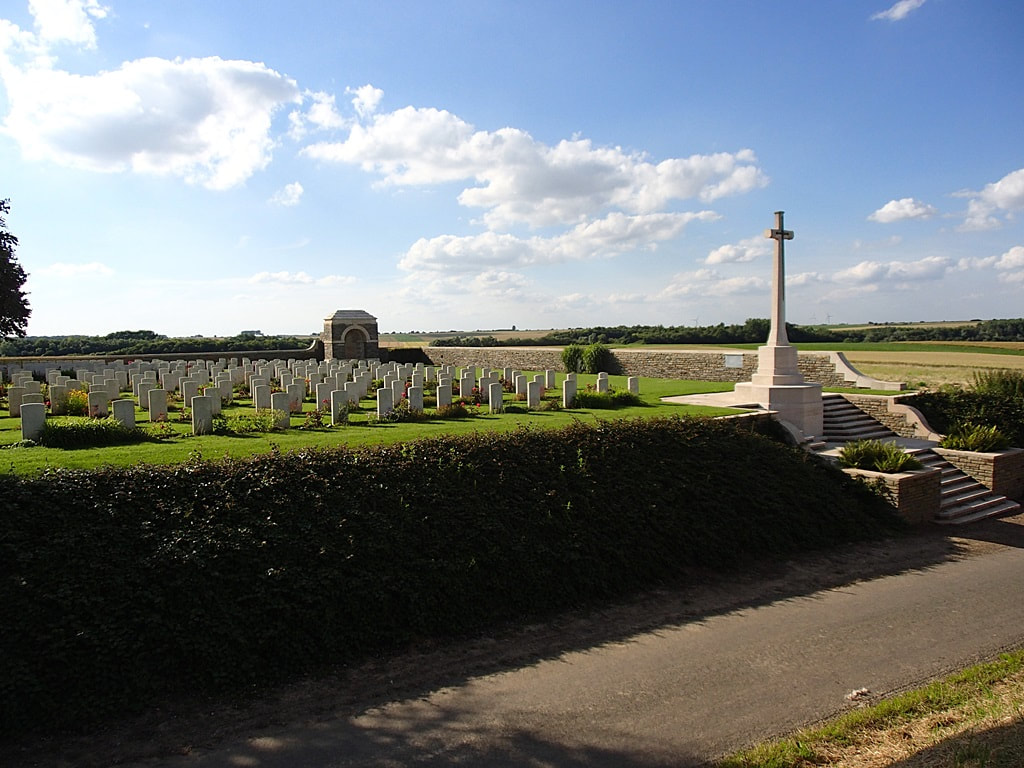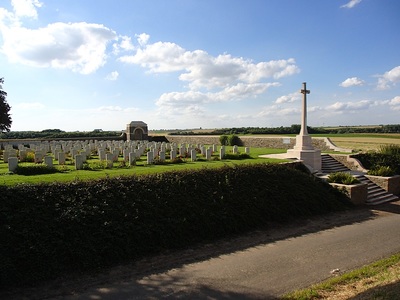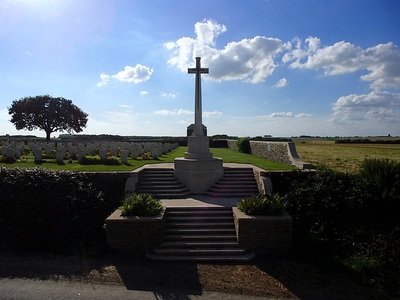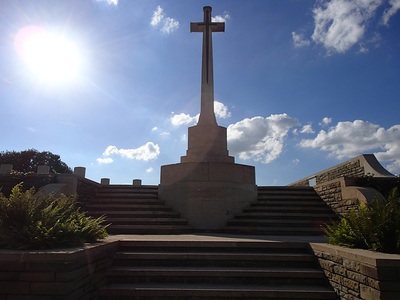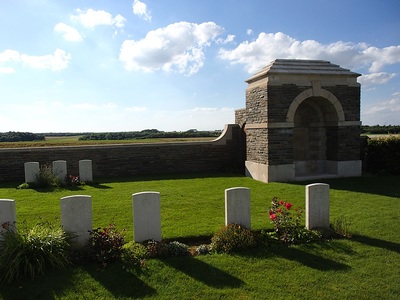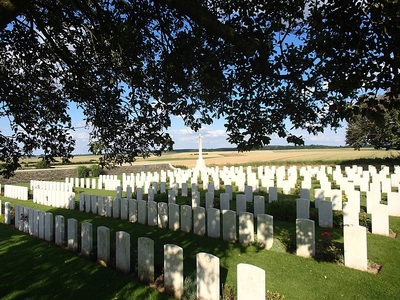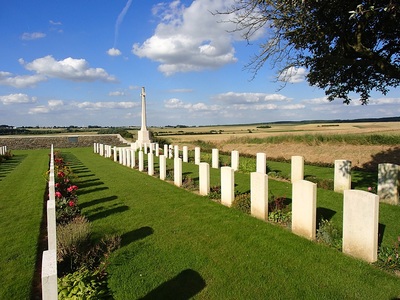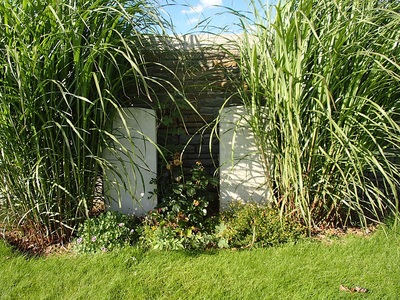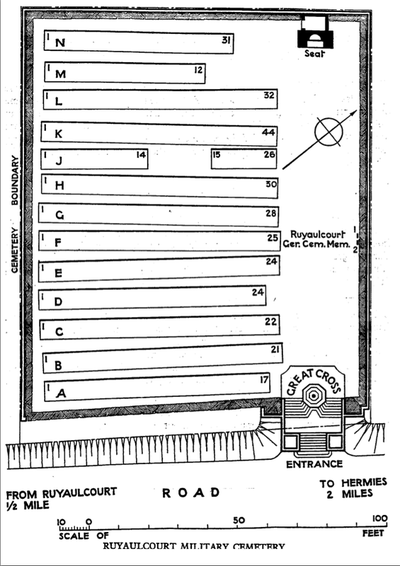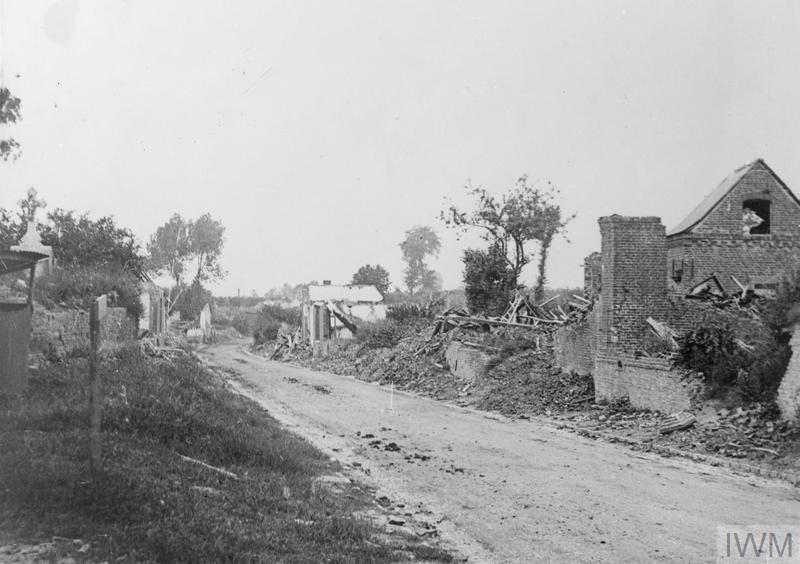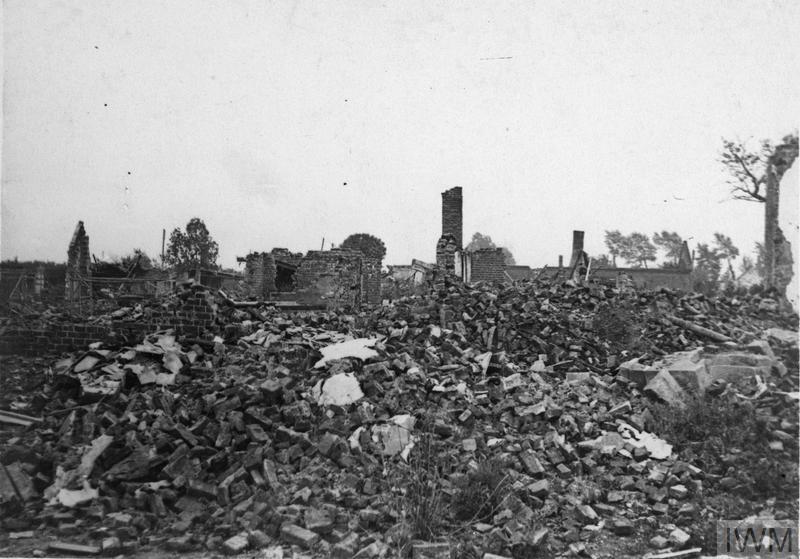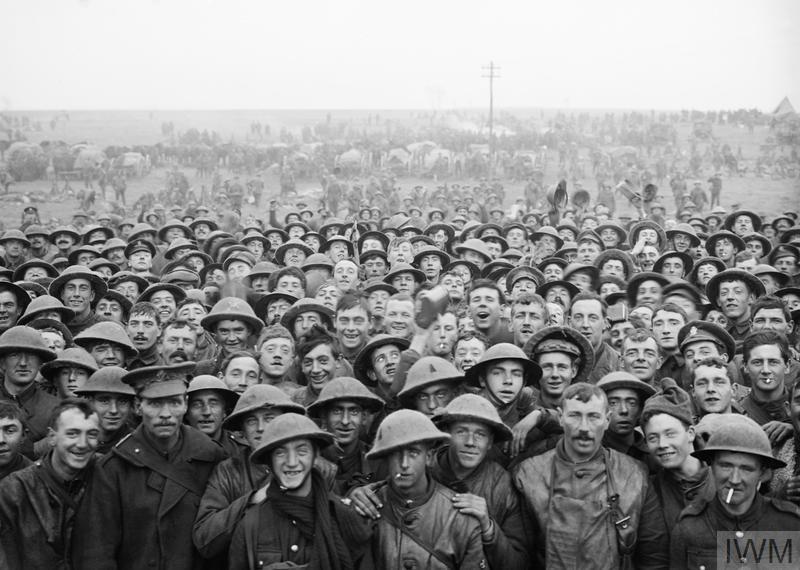RUYAULCOURT MILITARY CEMETERY
Pas De Calais
France
GPS Coordinates - Latitude: 50.08932, Longitude: 3.01901
Location Information
Ruyaulcourt is a village in the Department of the Pas-de-Calais 11 kilometres east of Bapaume on the D7 and 19 kilometres south-west of Cambrai.
The Cemetery lies 500 metres north of Ruyaulcourt village along an unmarked road, but is signposted to the left by the village church as you enter Ruyaulcourt from Bapaume.
Visiting Information
The location or design of this site makes wheelchair access impossible.
Historical Information
Ruyaulcourt village was attacked by the 7th D.C.L.I. on the 28th/29th March 1917 and found unoccupied the next night by the 7th Somerset Light Infantry. It was lost again on the 23rd March 1918 and finally cleared by the New Zealand Division on the 4th September 1918.
Ruyaulcourt German Cemetery was used from July 1916, to March 1917, and in August 1918; and it contained 405 German graves and those of two R.A.F. officers, two soldiers from the United Kingdom and one New Zealand soldier. It was removed in 1924, and two of the British graves were brought into the Military Cemetery.
Ruyaulcourt Military Cemetery was begun in April 1917, and used by fighting units and Field Ambulances (largely of the 42nd (East Lancashire) Division) until March 1918. It was re-opened in September 1918.
There are now over 300, 1914-18 war casualties commemorated in this site. Of these, 10 are unidentified and special memorials are erected to the two airmen buried in the German Cemetery, whose graves could not be found.
The Cemetery covers an area of 1,608 square metres and is enclosed by a rubble wall.
Casualty Details: UK 324, Canada 2, Australia 2, New Zealand 20, Total Burials: 348.
Dedications
277193 Private John Bain, 10th Bn. Argyll & Sutherland Highlanders, died 20th August 1917, aged 20.
Remembered with honour by great nephew John Hartshorn
Ruyaulcourt is a village in the Department of the Pas-de-Calais 11 kilometres east of Bapaume on the D7 and 19 kilometres south-west of Cambrai.
The Cemetery lies 500 metres north of Ruyaulcourt village along an unmarked road, but is signposted to the left by the village church as you enter Ruyaulcourt from Bapaume.
Visiting Information
The location or design of this site makes wheelchair access impossible.
Historical Information
Ruyaulcourt village was attacked by the 7th D.C.L.I. on the 28th/29th March 1917 and found unoccupied the next night by the 7th Somerset Light Infantry. It was lost again on the 23rd March 1918 and finally cleared by the New Zealand Division on the 4th September 1918.
Ruyaulcourt German Cemetery was used from July 1916, to March 1917, and in August 1918; and it contained 405 German graves and those of two R.A.F. officers, two soldiers from the United Kingdom and one New Zealand soldier. It was removed in 1924, and two of the British graves were brought into the Military Cemetery.
Ruyaulcourt Military Cemetery was begun in April 1917, and used by fighting units and Field Ambulances (largely of the 42nd (East Lancashire) Division) until March 1918. It was re-opened in September 1918.
There are now over 300, 1914-18 war casualties commemorated in this site. Of these, 10 are unidentified and special memorials are erected to the two airmen buried in the German Cemetery, whose graves could not be found.
The Cemetery covers an area of 1,608 square metres and is enclosed by a rubble wall.
Casualty Details: UK 324, Canada 2, Australia 2, New Zealand 20, Total Burials: 348.
Dedications
277193 Private John Bain, 10th Bn. Argyll & Sutherland Highlanders, died 20th August 1917, aged 20.
Remembered with honour by great nephew John Hartshorn
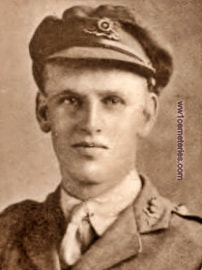
Lieutenant
Edward Henry Burgh, M. C.
"B" Boy. 223rd Bde. Royal Field Artillery
4th January 1918, aged 21.
Row H. 11.
Son of the Rev. Henry Ulysses Burgh and Marian Henrietta Burgh, of the Vicarage, Preston Patrick, Milnthorpe, Westmorland. Born at St. Bees, Cumberland. Medical student Edinburgh University.
Edward Henry Burgh, M. C.
"B" Boy. 223rd Bde. Royal Field Artillery
4th January 1918, aged 21.
Row H. 11.
Son of the Rev. Henry Ulysses Burgh and Marian Henrietta Burgh, of the Vicarage, Preston Patrick, Milnthorpe, Westmorland. Born at St. Bees, Cumberland. Medical student Edinburgh University.
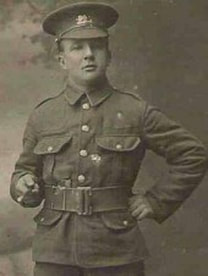
306878 Private
Thomas Dennison
1st/8th Bn. Lancashire Fusiliers
13th June 1917, aged 17.
Row B. 3.
Son of William and Susannah Dennison, of St. Anne's-on-the-Sea, Lancs.
His headstone bears the inscription: "Until The Day Dawns And The Shadows Flee Away."
One of three brothers killed during the First World War
Picture courtesy of Stephen Singleton
Thomas Dennison
1st/8th Bn. Lancashire Fusiliers
13th June 1917, aged 17.
Row B. 3.
Son of William and Susannah Dennison, of St. Anne's-on-the-Sea, Lancs.
His headstone bears the inscription: "Until The Day Dawns And The Shadows Flee Away."
One of three brothers killed during the First World War
Picture courtesy of Stephen Singleton
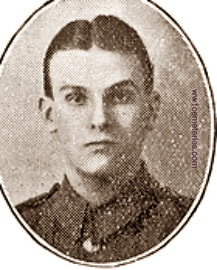
520309 Sapper
Joseph Henry Edwards
565th Army Troops Coy. Royal Engineers
18th September 1918.
Row M. 6.
Joseph Henry Edwards
565th Army Troops Coy. Royal Engineers
18th September 1918.
Row M. 6.
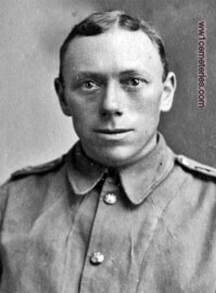
200081 Serjeant
Benjamin Nicholas
1st/4th Bn. King's Shropshire Light Infantry
30th December 1917.
Row G. 24.
Benjamin Nicholas
1st/4th Bn. King's Shropshire Light Infantry
30th December 1917.
Row G. 24.
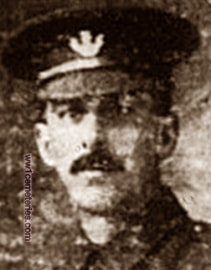
201756 Private
Thomas Alfred People
1st/5th Bn. Manchester Regiment
8th July 1917.
Row E. 6.
Thomas Alfred People
1st/5th Bn. Manchester Regiment
8th July 1917.
Row E. 6.
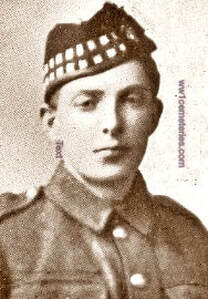
S/16996 Private
John Manson Sandison
7th Bn. Seaforth Highlanders
7th August 1917, aged 21.
Row E. 18.
Son of Andrew and Mary Sandison, of Sandwich, Hillswick, Shetland Isles.
John Manson Sandison
7th Bn. Seaforth Highlanders
7th August 1917, aged 21.
Row E. 18.
Son of Andrew and Mary Sandison, of Sandwich, Hillswick, Shetland Isles.
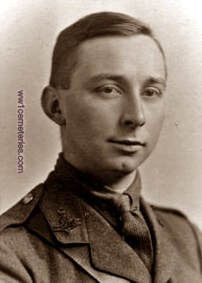
Captain
Arthur Wilson Simpkin
13th Bn. Yorkshire Regiment attd. 8th Bn. West Yorkshire Regiment (Prince of Wales's Own)
30th September 1918, aged 22.
Row N. 28.
Son of J. W. and Emily Simpkin, of Norton Royd, Woodkirk, Dewsbury, Yorks.
His headstone bears the inscription: "Also In Memory Of His Brother Captain H.H. Simpkin Age 21, 13th York's Regt. 22.3.1918. Have Faith In God."
Arthur Wilson Simpkin
13th Bn. Yorkshire Regiment attd. 8th Bn. West Yorkshire Regiment (Prince of Wales's Own)
30th September 1918, aged 22.
Row N. 28.
Son of J. W. and Emily Simpkin, of Norton Royd, Woodkirk, Dewsbury, Yorks.
His headstone bears the inscription: "Also In Memory Of His Brother Captain H.H. Simpkin Age 21, 13th York's Regt. 22.3.1918. Have Faith In God."
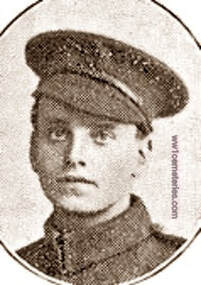
520187 Sapper
Sidney Arthur Sinnett
565th Army Troops Coy. Royal Engineers
18th September 1918.
Row M. 6.
Sidney Arthur Sinnett
565th Army Troops Coy. Royal Engineers
18th September 1918.
Row M. 6.

